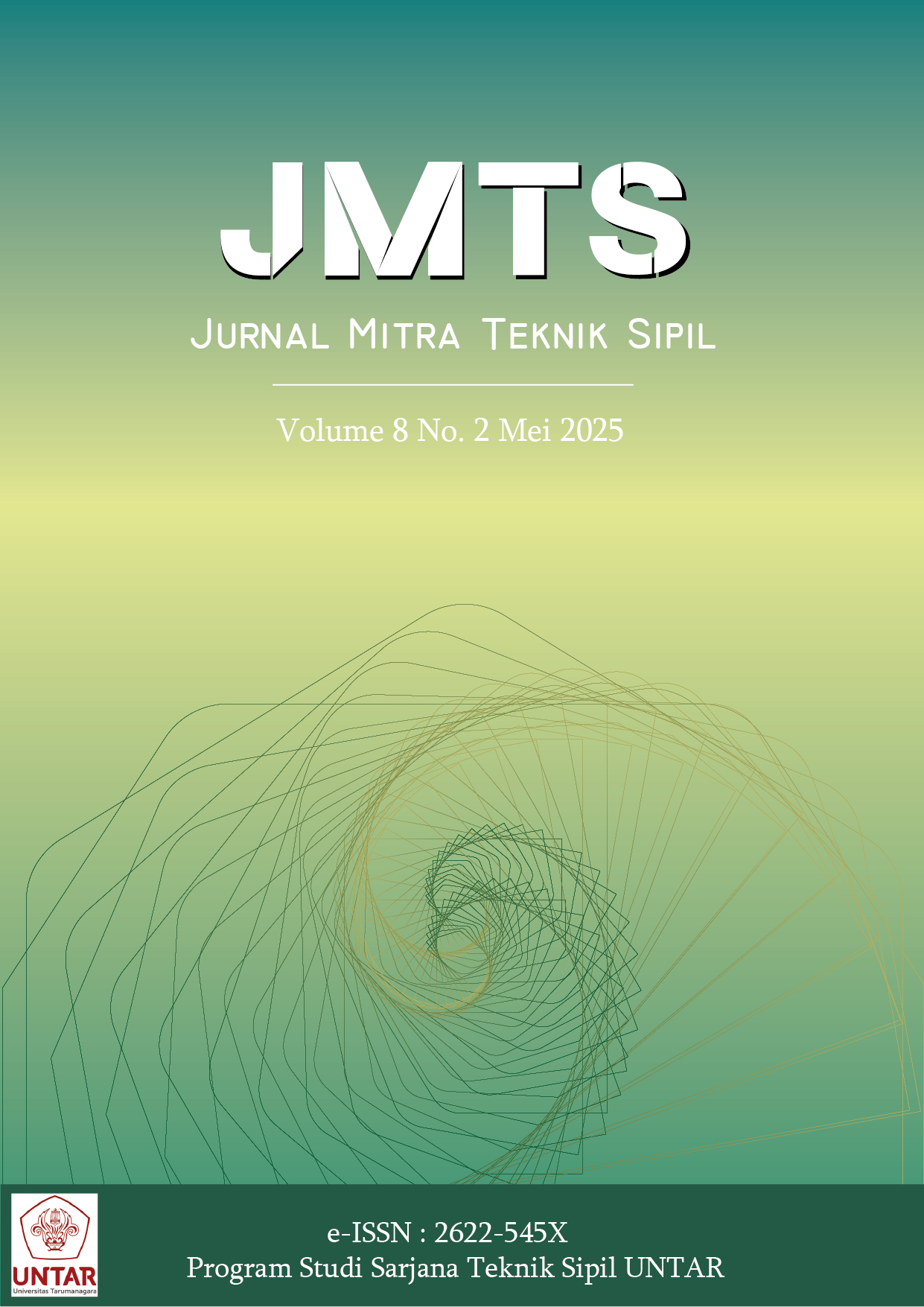PENGARUH KEDALAMAN PENGANGKURAN TERHADAP KUAT TARIK ANGKUR ADHESIF PADA JARAK TEPI KRITIS
Main Article Content
Abstract
Over time, technology and materials in the construction industry have continued to evolve. One such advancement is adhesive post-installed anchors. These anchors are inserted into hardened concrete using adhesive material to create bonds between the adhesive, the concrete surface, and the fastening element. The relatively fast curing time and installation flexibility are advantages of adhesive post-installed anchors. Factors influencing anchor pull-out strength include embedment depth and edge distance. SNI 2847:2019 regulates rebar development length and anchor edge distance. However, field observations don't always align with applicable rules. Advanced adhesive anchor product technology can also impact field anchor application methods. This study tests the pull-out strength of adhesive post-installed anchors set in 40 MPa concrete with embedment depth follows practical field rules (10db) and theoretical calculations (SNI 2847:2019 Chapter 25.4.2.1), with a critical edge distance of 40mm using Hilti HIT-RE 500 V3 adhesive material and Baja Perkasa Sentosa’s grade 420B reinforcement bar with 13mm dan 16mm diameters.. Test results showed the ratio of pull-out tensile capacity field practical to theoretical embedment for 13 mm diameter anchors is 0,7324 and for 16 mm diameter anchors is 0,7374.
Abstrak
Seiring dengan perkembangan waktu, teknologi dan material pada dunia konstruksi terus mengalami perkembangan. Salah satunya adalah angkur pasca pasang adhesif. Angkur adhesif adalah angkur yang dimasukkan ke dalam beton yang sudah mengeras dengan memanfaatkan bahan perekat untuk membentuk ikatan. Waktu curing yang cepat dan fleksibilitas pemasangan menjadi keunggulan angkur adhesif. Faktor yang berpengaruh terhadap kuat tarik angkur antara lain kedalaman penanaman dan jarak tepi angkur. SNI 2847:2019 telah mengatur mengenai kedalaman penyaluran tulangan dan jarak tepi angkur. Akan tetapi, fakta yang terjadi di lapangan tidak selalu sesuai dengan aturan yang berlaku. Perkembangan teknologi produk angkur adhesif yang semakin maju juga dapat mempengaruhi metode pengaplikasian angkur di lapangan. Pada penelitian ini dilakukan pengujian tarik terhadap angkur pasca pasang adhesif yang dipasang pada beton kuat rencana 40 MPa dengan kedalaman penanaman berdasarkan aturan praktis di lapangan (10db) dan analisis teoritis pada jarak tepi kritis sebesar 40 mm menggunakan bahan adhesif Hilti HIT-RE 500 V3 dan besi tulangan kelas 420B merk Baja Perkasa Sentosa diameter 13mm dan 16mm. Dari hasil pengujian, diperoleh rasio kapasitas kuat tarik pengangkuran (kedalaman 10db) dibanding penyaluran (kedalaman sesuai SNI 2847:2019 Pasal 25.4.2.1) untuk angkur berdiameter 13 mm sebesar 0,7324 dan untuk angkur berdiameter 16 mm sebesar 0,7374.
Article Details

This work is licensed under a Creative Commons Attribution-NonCommercial-ShareAlike 4.0 International License.
This work is licensed under Jurnal Mitra Teknik Sipil (JMTS) Creative Commons Attribution-ShareAlike 4.0 International License.References
Ananta, B. D., & Apriyatno, H. (2022). Eksperimen kuat lekat chemical angkur deform kedalaman 110 mm metode cast-in place dan post-installed drill bit extractor. Jurnal Ilmiah Multidisiplin Indonesia, 2(3), 2807-5994.
ASTM. (2015). Standard test methods for strength of anchors in concrete elements. ASTM E488/E488M-15.
Badan Standardisasi Nasional. (2019). Persyaratan beton struktural untuk bangunan gedung dan penjelasan (SNI 2847:2019). http://sispk.bsn.go.id/SNI/DaftarList
Burtz, J. L. (2003). Behavior and design of grouted anchors loaded in tension including edge and group effects and qualification of engineered grout products [Master Thesis, University of Florida]. https://ufdcimages.uflib.ufl.edu/UF/E0/00/08/54/00001/burtz_j.pdf
Cheok, G. and Phan, L. (1998), Post-installed anchors: a literature review, NIST Interagency/Internal Report (NISTIR), National Institute of Standards and Technology, Gaithersburg, MD (Accessed April 4, 2025). https://www.nist.gov/publications/post-installed-anchors-literature-review
Dewobroto, W. (2016). Struktur Baja - Perilaku, Analisis & Desain. Universitas Pelita Harapan.
HILTI. (2023). HIT-RE 500 V3 Injection Mortar Technical Datasheet.
Tarawneh, A. N. (2019). Behavior and design of post-installed anchors in thin concrete members [Doctoral dissertation, Clemson University]. https://core.ac.uk/download/pdf/268683974.pdf



